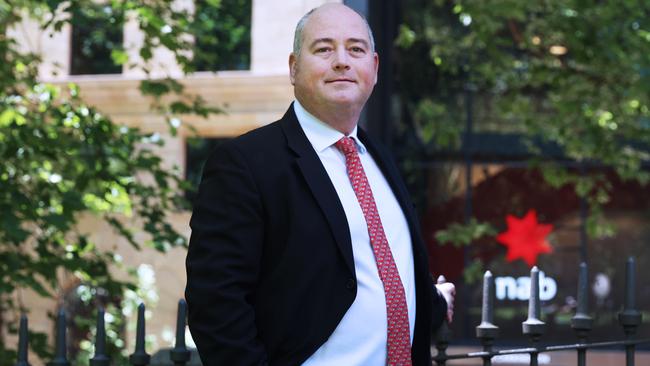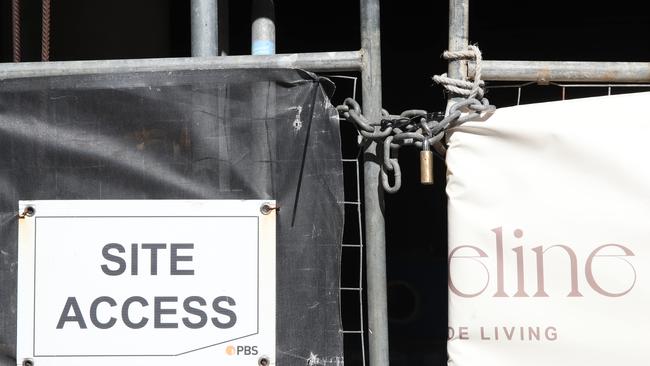NAB boss Andrew Irvine warns of bad loan spike amid tough economy
NAB’s so-called ‘watch loans’ climbed to its highest level since mid-2022 as CEO Andrew Irvine warned of a further increase in troubled business borrowers.

National Australia Bank boss Andrew Irvine has cautioned of a further increase in troubled business loans, as the lender reported a spike in those on its watch list and noted a range of industries were struggling within a tougher operating environment.
As he handed down the bank’s annual results, Mr Irvine called out loan stress and impairments at NAB across business customers in industries including construction, agribusiness, manufacturing, discretionary spending-related industries and supply chain-linked companies in food-related sectors.
“It’s really broad based, which means that there isn’t a particular sector that’s causing undue negative outcomes,” he said.
NAB’s so-called “watch loans” climbed to 1.21 per cent of gross loans and acceptances, largely driven by business and private bank lending, and represented the highest level since mid-2022. Watch loans at NAB are typically flagged by bankers making referrals or manually downgrading a customer rating as part of a review.
The bank’s total non-performing loans jumped 26 basis points to 1.39 per cent in the year ended September 30, from a year earlier. That level was the highest in since September 2021, albeit there were some measurement changes.
Mr Irvine said he “fully expects” arrears in small and medium business loans to push higher in the coming months, as home loan arrears approach their peak.
“The SME cycle will lag the consumer cycle,” he added.
“So we would expect that when we hit a point of peak arrears in the home lending book, it’s likely the SME cycle will follow that.”
NAB also said it had company-specific exposures within its business loan book that it was watching, some of which were classified as individually assessed provisions.
While the bank didn’t identify specific customers, NAB was a financier to ASX-listed Beston Global Food which was placed in administration in September.
Banking analysts said they would closely watch NAB’s loan arrears over coming months, given the acceleration.
“Asset quality continues to deteriorate, with manufacturing the key sector under pressure,” Barrenjoey analyst Jon Mott said.
Citigroup analyst Brendan Sproules said: “This (loan quality) could become a drag on NAB’s overall performance as it has a greater book mix skew to business vs peers.”

NAB chief financial officer Nathan Goonan noted, however, the bank had already positioned for an uptick in business loan arrears.
“We are well prepared for this situation,” he said. NAB’s total provisions edged up to $5.9bn as at September 30.
The bank’s 90-day mortgage delinquency rate rose to 1.08 per cent versus 0.76 per cent a year ago, but Mr Irvine said hardship applications peaked in June and July.
“We’re at the toughest point in the economic cycle right now,” he added.
On home lending, Mr Irvine put the bank’s weak growth in the segment down to its retreat from writing loans below the cost of capital and a hefty reliance on brokers versus in-house loan origination. The bank grew its home loan book 3 per cent in fiscal 2024, below the industry’s system growth.
“Had we been better in proprietary home lending over the course of the last year, we would have held up better in terms of our growth vis-a-vis system,” Mr Irvine said.
“In proprietary lending, these are more relationship-based clients and on the margin, less price sensitive. We need to hire more proprietary bankers, and we need to enable those bankers with better digital data and analytics tooling so that they can be effective in the marketplace. So that’s going to be a real focus for us.”
Mr Irvine said the lender had stepped back into the home lending market in the second half as discounting eased, but that it may retreat again if competition picked up and made pricing irrational.
“We made the deliberate decision to not take part in the very strong mortgage discounting that was happening earlier in the year. That abated in the second half of the year and as a result, we’ve chosen to meet the market given we’re getting better economics,” Mr Irvine said.
“I think in the next two or three months, you’ll see NAB performing at or about system.
“This is a dynamic market, but you know, you can rely on that to continue to be disciplined, and if the economics revert back to what we were seeing in the first half of the year, we might make the same decision (to step out of the home lending market) again.”




To join the conversation, please log in. Don't have an account? Register
Join the conversation, you are commenting as Logout